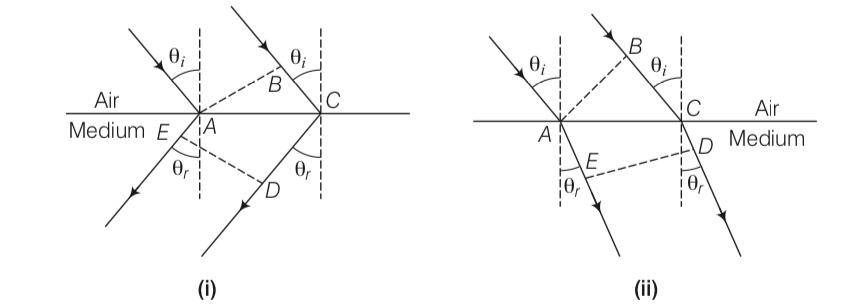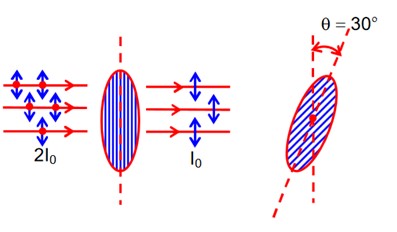The optical properties of a medium are governed by the relative permittivity (εr) and relative permeability (μr). The refractive index is defined as
= n.For ordinary material εr > 0 and μr > 0 and the positive sign is taken for the square root. In 1964, a Russian scientist V. Veselago postulated the existence of material with εr < 0 and μr < 0. Since then such ‘metamaterials’ have been produced in the laboratories and their optical properties studied. For such materials n = –
. As light enters a medium of such refractive index the phases travel away from the direction of propagation. (i) According to the description above show that if rays of light enter such a medium from air (refractive index =1) at an angle θ in 2nd quadrant, them the refracted beam is in the 3rd quadrant. (ii) Prove that Snell’s law holds for such a medium.
The optical properties of a medium are governed by the relative permittivity (εr) and relative permeability (μr). The refractive index is defined as = n.For ordinary material εr > 0 and μr > 0 and the positive sign is taken for the square root. In 1964, a Russian scientist V. Veselago postulated the existence of material with εr < 0 and μr < 0. Since then such ‘metamaterials’ have been produced in the laboratories and their optical properties studied. For such materials n = – . As light enters a medium of such refractive index the phases travel away from the direction of propagation. (i) According to the description above show that if rays of light enter such a medium from air (refractive index =1) at an angle θ in 2nd quadrant, them the refracted beam is in the 3rd quadrant. (ii) Prove that Snell’s law holds for such a medium.
-
1 Answer
-
This is a Long Answer Type Questions as classified in NCERT Exemplar
Explanation-All points with the same optical path length must have the same phase.

So – =BC-–
BC= (CD-AE)
BC>0, si must be greater than AD
But in other figure
–
So BC= –
But clearly here BE is less than zero
To proving snells law we know that
BC=ACsin and CD-AE=ACsin
So n= sini/sinr
Similar Questions for you
The angle between the plane of vibration and plane of polarization is 90°.
At lower end
Tension, T? = 2g = 20 N (due to the 2 kg block)
Velocity, v? = √ (T? /μ) = √ (20/μ)
Wavelength, λ? = 6 cm
At upper end
Tension, T? = (2 kg + 6 kg)g = 8g = 80 N (due to the block and the rope)
Velocity, v? = √ (T? /μ) = √ (80/μ) = √4 * √ (20/μ) = 2v?
Since frequency (f) remains the same:
f = v? /λ? = v? /λ?
⇒ λ? = λ? * (v? /v? )
⇒ λ? = λ? * (2v? /v? ) = 2λ?
⇒ λ? = 2 * 6 cm = 12 cm
β = λD / (d? + a? sinωt)
β? - β? = λD/ (d? - a? ) - λD/ (d? + a? )
= λD [ (d? + a? ) - (d? - a? ) / (d? ² - a? ²) ]
= 2λDa? / (d? ² - a? ²)
3d = 0.6mm
D = 80cm
= 800mm
Path difference is given by
BP – Andhra Pradesh = Dx
[for Dark fringe at P]
n = 0, for first dark fringe
first dark fringe is observed on the screen directly opposite to one of the slits]
Taking an Exam? Selecting a College?
Get authentic answers from experts, students and alumni that you won't find anywhere else
Sign Up on ShikshaOn Shiksha, get access to
- 65k Colleges
- 1.2k Exams
- 678k Reviews
- 1800k Answers

